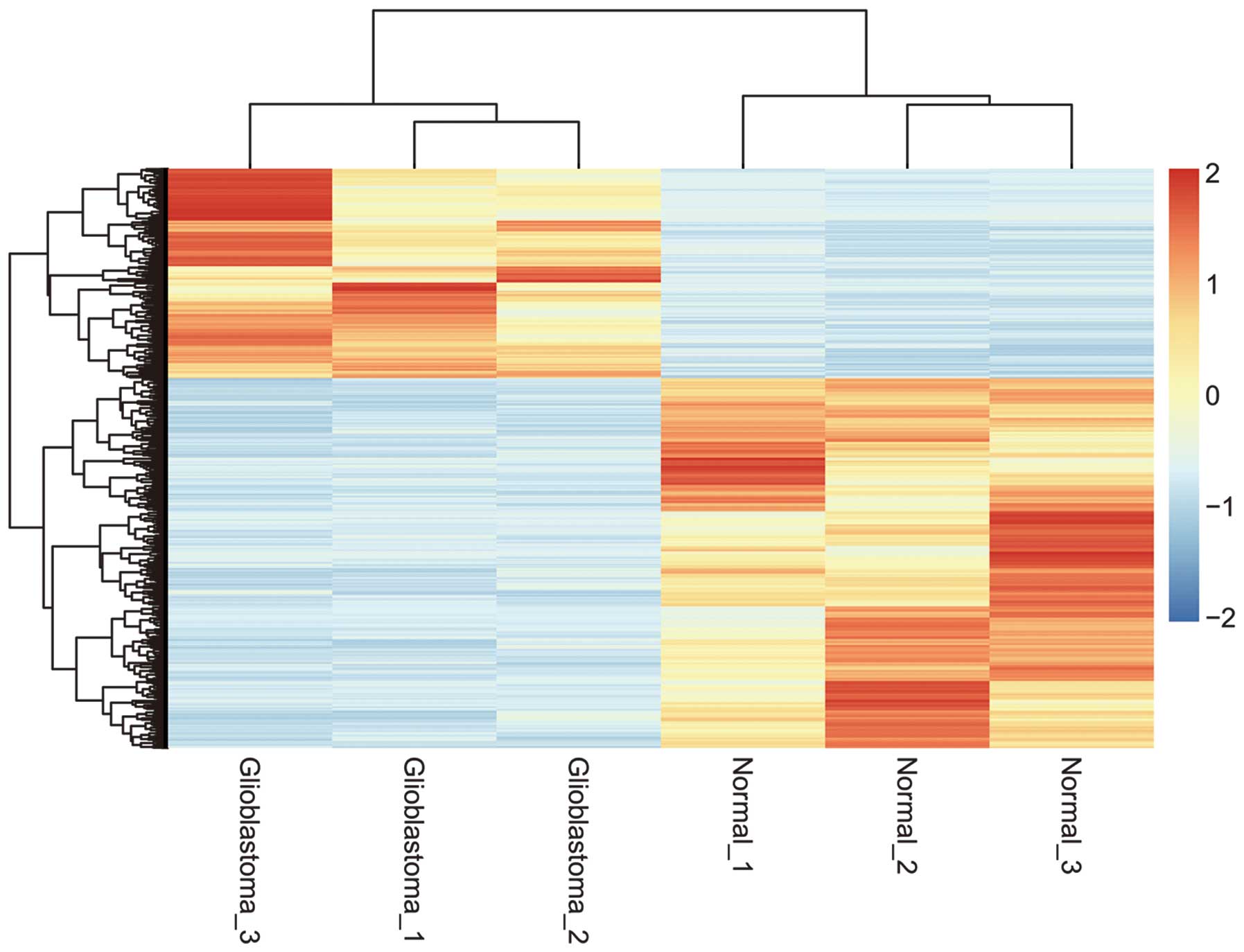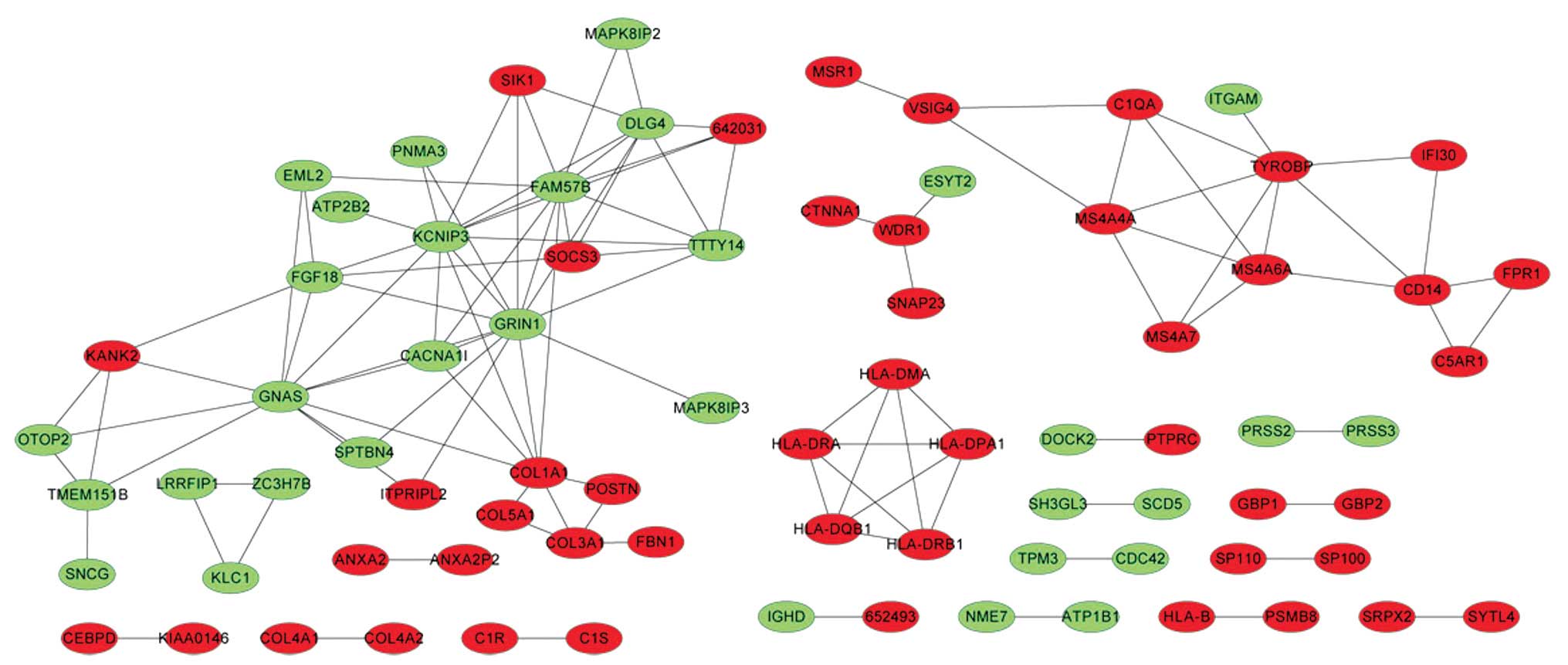|
1
|
Buckner JC: Factors influencing survival
in high-grade gliomas. Seminars in oncology. Elsevier; pp. 10–14.
2003, View Article : Google Scholar
|
|
2
|
Dubrow R, Darefsky AS, Jacobs DI, et al:
Time trends in glioblastoma multiforme survival: the role of
temozolomide. Neuro Oncol. 15:1750–1761. 2013. View Article : Google Scholar : PubMed/NCBI
|
|
3
|
Liu Z, Niu Y, Xie M, Bu Y, Yao Z and Gao
C: Gene expression profiling analysis reveals that DLG3 is
down-regulated in glioblastoma. J Neurooncol. 116:465–476. 2014.
View Article : Google Scholar : PubMed/NCBI
|
|
4
|
Saggioro FP, Neder L, Stávale JN, et al:
Fas, FasL and cleaved caspases 8 and 3 in glioblastomas: a tissue
microarray-based study. Pathol Res Pract. 210:267–273. 2014.
View Article : Google Scholar : PubMed/NCBI
|
|
5
|
Aghi M and Chiocca EA: Gene therapy for
glioblastoma. Neurosurg Focus. 20:E18. 2006.PubMed/NCBI
|
|
6
|
Mischel PS, Cloughesy TF and Nelson SF:
DNA-microarray analysis of brain cancer: molecular classification
for therapy. Nat Rev Neurosci. 5:782–792. 2004. View Article : Google Scholar : PubMed/NCBI
|
|
7
|
Chen JX, Lu YC, Luo C, et al: Expression
and function of differentially expressed genes in glioblastoma by
using cDNA microarray. AJSMMU. 25:498–502. 2004.
|
|
8
|
Zhao Z, Lu Y, Chen J, Hou L-j, Hu G-h and
Luo C: Using Bioinformatics Method to Investigate the Genes Related
to Chemosensitivity in Human Glioblastoma. Prog Mod Biomed.
19:0032011.
|
|
9
|
Fujita A, Sato JR, Rodrigues LO, Ferreira
CE and Sogayar MC: Evaluating different methods of microarray data
normalization. BMC Bioinformatics. 7:4692006. View Article : Google Scholar : PubMed/NCBI
|
|
10
|
Gentleman R, Carey V, Huber W, Irizarry RA
and Dudoit S: Bioinformatics and computational biology solutions
using R and Bioconductor. Springe. 2005. View Article : Google Scholar
|
|
11
|
Szekely GJ and Rizzo ML: Hierarchical
clustering via joint between-within distances: Extending Ward’s
minimum variance method. J Classif. 22:151–183. 2005. View Article : Google Scholar
|
|
12
|
Deza MM and Deza E: Encyclopedia of
distances. Springer; 2009, View Article : Google Scholar
|
|
13
|
Obayashi T, Hayashi S, Shibaoka M, Saeki
M, Ohta H and Kinoshita K: COXPRESdb: a database of coexpressed
gene networks in mammals. Nucleic Acids Res. 36:D77–D82. 2008.
View Article : Google Scholar :
|
|
14
|
Janaki C and Joshi RR: Motif detection in
Arabidopsis: Correlation with gene expression data. In Silico Biol.
4:149–161. 2004.PubMed/NCBI
|
|
15
|
Smoot ME, Ono K, Ruscheinski J, Wang PL
and Ideker T: Cytoscape 2.8: new features for data integration and
network visualization. Bioinformatics. 27:431–432. 2011. View Article : Google Scholar :
|
|
16
|
Huang da W, Sherman BT and Lempicki RA:
Systematic and integrative analysis of large gene lists using DAVID
bioinfor-matics resources. Nat Protoc. 4:44–57. 2009. View Article : Google Scholar
|
|
17
|
Dudoit S, Shaffer JP and Boldrick JC:
Multiple hypothesis testing in microarray experiments. Stat Sci.
18:71–103. 2003. View Article : Google Scholar
|
|
18
|
Kanehisa M, Goto S, Hattori M, et al: From
genomics to chemical genomics: new developments in KEGG. Nucleic
Acids Res. 34:D354–D357. 2006. View Article : Google Scholar :
|
|
19
|
Kanehisa M, Goto S, Kawashima S, Okuno Y
and Hattori M: The KEGG resource for deciphering the genome.
Nucleic Acids Res. 32:D277–D280. 2004. View Article : Google Scholar :
|
|
20
|
Stower H: Gene regulation: Resolving
transcription factor binding. Nat Rev Genet. 13:71. 2011.PubMed/NCBI
|
|
21
|
Han L, Suzek TO, Wang Y and Bryant SH: The
text-mining based PubChem bioassay neighboring analysis. BMC
Bioinformatics. 11:5492010. View Article : Google Scholar : PubMed/NCBI
|
|
22
|
Ohgaki H and Kleihues P: Epidemiology and
etiology of gliomas. Acta Neuropathol. 109:93–108. 2005. View Article : Google Scholar : PubMed/NCBI
|
|
23
|
Wechsler-Reya R and Scott MP: The
developmental biology of brain tumors. Annu Rev Neurosci.
24:385–428. 2001. View Article : Google Scholar : PubMed/NCBI
|
|
24
|
Shiina T, Inoko H and Kulski J: An update
of the HLA genomic region, locus information and disease
associations: 2004. Tissue Antigens. 64:631–649. 2004. View Article : Google Scholar : PubMed/NCBI
|
|
25
|
Jäger E, Chen YT, Drijfhout JW, et al:
Simultaneous humoral and cellular immune response against
cancer-testis antigen NY-ESO-1: Definition of human
histocompatibility leukocyte antigen (HLA)-A2-binding peptide
epitopes. J Exp Med. 187:265–270. 1998. View Article : Google Scholar : PubMed/NCBI
|
|
26
|
Palucka K, Ueno H and Banchereau J: Recent
developments in cancer vaccines. J Immunol. 186:1325–1331. 2011.
View Article : Google Scholar : PubMed/NCBI
|
|
27
|
Neefjes J, Jongsma ML, Paul P and Bakke O:
Towards a systems understanding of MHC class I and MHC class II
antigen presentation. Nat Rev Immunol. 11:823–836. 2011.PubMed/NCBI
|
|
28
|
Boudjema A, Petit-Teixeira E, Cornelis F
and Benhamamouch S: HLA-DMA and DMB genes in rheumatoid arthritis.
Tissue Antigens. 79:155–156. 2012. View Article : Google Scholar : PubMed/NCBI
|
|
29
|
Kiepiela P, Leslie AJ, Honeyborne I, et
al: Dominant influence of HLA-B in mediating the potential
co-evolution of HIV and HLA. Nature. 432:769–775. 2004. View Article : Google Scholar : PubMed/NCBI
|
|
30
|
Wei J, Barr J, Kong LY, et al:
Glioma-associated cancer-initiating cells induce immunosuppression.
Clin Cancer Res. 16:461–473. 2010. View Article : Google Scholar : PubMed/NCBI
|
|
31
|
Machulla HK, Steinborn F, Schaaf A,
Heidecke V and Rainov NG: Brain glioma and human leukocyte antigens
(HLA)-is there an association. J Neurooncol. 52:253–261. 2001.
View Article : Google Scholar : PubMed/NCBI
|
|
32
|
Moreau A, Varey E, Anegon I and Cuturi MC:
Effector mechanisms of rejection. Cold Spring Harb Perspect Med.
3:a0154612013. View Article : Google Scholar : PubMed/NCBI
|
|
33
|
Le Moine A, Goldman M and Abramowicz D:
Multiple pathways to allograft rejection. Transplantation.
73:1373–1381. 2002. View Article : Google Scholar : PubMed/NCBI
|














